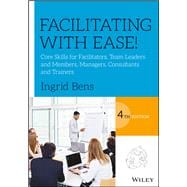The definitive guide to running productive meetings
Facilitating With Ease! has become the go-to handbook for those who lead meetings, training, and other business gatherings. Packed with information, effective practices, and invaluable advice, this book is the comprehensive handbook for anyone who believes meetings should be productive, relevant, and as short as possible. Dozens of exercises, surveys, and checklists will help transform anyone into a skilled facilitator, and clear, actionable guidance makes implementation a breeze. This new fourth edition includes a new chapter on questioning, plus new material surrounding diversity, globalization, technology, feedback, distance teams, difficult executives, diverse locations, personal growth, meeting management, and much more. With in-depth, expert guidance from planning to closing, this book provides facilitators with an invaluable resource for learning or training.
Before you run another meeting, discover the practices, processes, and techniques that turn you from a referee to an effective facilitator. This book provides a wealth of tools and insights that you can put into action today.
- Run productive meetings that get real results
- Keep discussions on track and facilitate the exchange of ideas
- Resolve conflict and deal with difficult individuals
- Train leaders and others to facilitate effectively
Poorly-run meetings are an interruption in the day, and accomplish little other than putting everyone behind in their “real” work. On the other hand, a meeting run by an effective facilitator makes everyone’s job easier; decisions get made, strategies are improved, answers are given, and new ideas bubble to the surface. A productive meeting makes everyone happy, and results in real benefits that spread throughout the organization. Facilitating With Ease! is the skill-building guide to running great meetings with confidence and results.








